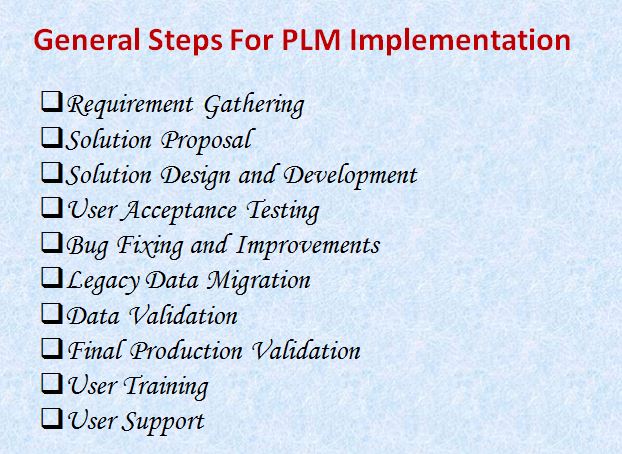
Any software’s implementation process has to go through certain stages. Here we have tried to list down the different stages that are important for any PLM implementation project. Steps may differ based on the industry requirement or complexity of the process.
Let’s try to understand the general steps one by one.
1. Requirement Gathering
The first step of any PLM Implementation project is to analyze and understand the existing industry process and culture. Generally, workshops are conducted where the implementation team interacts with the customer and understands the ground-level requirement. During requirement gathering, a requirement specification document is prepared which contains details of customer requirements. At this stage, the implementation team takes approval of requirements from customers on the requirement specification document.
2. Solution Proposal
The solution development team decides and develops the detailed solution design document based on the requirement specification document. The solution design document contains a detailed technical solution that is going to be implemented based on the requirement. Sometimes for critical requirements, a small POC (Proof of Concept) is developed and shown to the customer. Customer agreement is taken on the overall solution proposal at this stage.
3. Solution Design and development
Once the customer agrees on the proposed solution then the development team plans and decides the detailed solution development approach. The solution is developed in different phases based on the complexity of the requirement. PLM application works closely with ERP and CAD applications. In some cases as per business process requirements integration framework is developed to share information from PLM to ERP or CAD application and vice-versa. Sometimes companies want to use legacy applications for some processes. The solution is designed and developed to ensure a smooth flow of data between legacy applications and new PLM applications.
4. User Acceptance Testing
In this stage, user’s from the client-side test the developed functionality on the UAT servers. The implementation team prepares and shares the detailed stepwise document to execute the developed functionality. User tests the functionality based on different scenarios and reports to the implementation team about the bugs identified and the improvements if needed.
5. Bug Fixing And Improvements
During UAT users may come across some bugs in the development or suggests improvement in the functionality as per need and use case. These bugs are fixed or improvements are implemented and given for the revalidation to the users.
6. Legacy Data Migration
Legacy data migration is a very important stage of any implementation project. No company wants to lose legacy data due to new applications. Generally, migration activity also starts parallel to an implementation activity. Identification of legacy data, mapping of legacy data with the new system, and identification of migration methodologies are the crucial steps for legacy data migration.
7. Data Validation
Legacy data is validated and tested with the new functionality. Sometimes functionality may need to change to support the legacy data. Missing or corrupted data is re-migrated and validated. Different validation scripts are used to validate the migrated data.
8. Final Production Validation
In this final stage, all functionalities are tested on the migrated data once. This stage is very important. If there is any critical issue then it can be identified and resolved at this stage before the go-live. If everything is fine then the only production go-live is planned.
9. User Training
Once the solution is fully developed and agreed upon, training is provided to required users. Different training sessions are conducted for responsible departments so that they can start using the system. Training can be provided online or at client location-based on requirement and feasibility. Though training is given to users, support is required to users while using the application.
10. User support
Once the project is implemented successfully, user support is required for few months or a few years based on the complexity of the process and agreement. Initially, the user usually needs support to use the new functionality. User-level issues may arise while using the application. The support team fixes these user-level issues and ensures the smooth running of the application.
What you learned in this article
We hope this article was informative and you got some basic idea about the different stages of the PLM implementation project. These steps may vary based on the business requirement, the complexity of the process, and the implementation approach. Please share your thoughts in the comment section or you can reach out to us using the contact form.

Awesome Content !
Thanks.